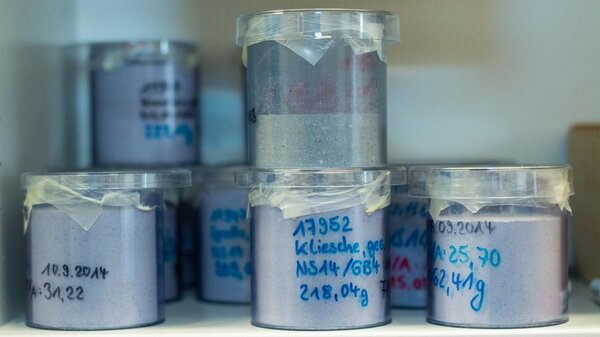Expertise
Who's afraid of caesium? – Radioactive substances in marine organisms
Marc-Oliver Aust | 2017
Control centres of the federal and state governments regularly check the distribution of radioactive substances in the environment and in food. The article provides information about radioactivity monitoring in the sea.
Radioactive substances have accompanied life on earth since its origin, however, their quantities - in a global perspective - have never been as low as they are today. The reason for this is simple: radioactive substances decay according to their half-life.
The most common radionuclide detected in organisms is the naturally occurring potassium-40, which has a half-life of 1.3 billion years. Potassium-40 is the only radiation-emitting isotope of potassium and is present in naturally occurring potassium at a mass fraction of 0.012 percent. Potassium is an essential trace element that plays a role in cell growth and blood pressure regulation, among other things. Thus, the potassium-40 provides a significant contribution to the radiation dose of humans through nutrition.
Caesium in the focus of radioactivity monitoring
However, the subject of public interest is a completely different radionuclide: cesium. From the human point of view, it is the counterpart of potassium, because it behaves similarly after absorption into the organism. Thus, the human organism is generally capable of dealing with radioactive substances as long as it is not exposed to too much of them.
Radioactive cesium isotopes (Cs-137, half-life of 30 years, and Cs-134, half-life of two years) are produced by nuclear fission, for example in the course of nuclear weapons testing or during energy production in nuclear power plants. For this reason, they are in focus of radioactivity monitoring. In Germany, this is regulated by the Precautionary Radiation Protection Act (Strahlenschutzvorsorgegesetz) and the recently passed Radiation Protection Act (Strahlenschutzgesetz) and subsequent ordinances. According to this laws, the measuring stations of the federal states randomly test various products, mostly food products, for radioactive substances, while the control centers of the federal government monitor the large-scale distribution of radioactive substances in the environment.
Highest contamination rates in the Irish Sea and the Baltic Sea
If suddenly higher concentrations of cesium isotopes are detected in the environment, monitoring must be extended to other radionuclides. The surface nuclear weapons tests of the 1950s and 1960s released the largest amount of cesium ever released by human activity into the world's oceans. But its isotopes are also released and enter the marine environment by accidents at the Chernobyl and Fukushima nuclear power plants and by emissions from the reprocessing plants at Sellafield, England, and La Hague, France.
Worldwide, the areas most contaminated with radionuclides are the Irish Sea (after the significant decrease in discharges from the Sellafield reprocessing plant, now still due to the release of contaminants stored in sediments ) and the Baltic Sea (due to its low water exchange, there is hardly any dilution of the fallout from Chernobyl).
But how do marine organisms live with it? Sometimes radioactive substances are mentioned in the media as a possible cause of mass deaths of fish and other marine animals, often even when scientific investigations have long since come to completely different conclusions. To date, however, neither in the Irish Sea nor in the Baltic Sea increased rates of illness or mortality of marine animals could be related to the occurrence of increased radioactivity.
Potential hazards to humans from man-made radioactive substances, resulting from the consumption of marine animals, are considered to be low, based on current knowledge. The radiation dose received by an average consumer of fish and fishery products (consumption of 5.6 kg of fish and 0.55 kg each of crustaceans and mollusks per year) from artificial radioactives is about 0.05 µSv per year, which is about 0.0022% of the mean natural radiation exposure.
Responsibilities of federal agencies
Within the framework of the Radiation Protection Act (Strahlenschutzgesetz), the following federal authorities are responsible for the large-scale determination of radioactivity:
- in air: Deutscher Wetterdienst (German Weather Service, DWD), partly in cooperation with the Bundesamt für Strahlenschutz (BfS) and the Physikalisch-Technische Bundesanstalt (PTB),
- in precipitation: Deutscher Wetterdienst (DWD),
- in federal waterways other than coastal waters (water, suspended solids, sediment): Bundesanstalt für Gewässerkunde (BfG),
- in North Sea and Baltic Sea including coastal waters (seawater, suspended matter, sediment): Bundesamt für Seeschifffahrt und Hydrographie (BSH),
- in marine organisms in the North Sea and Baltic Sea including coastal waters: Thünen Institute.







